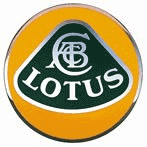Press
Press Releases
- Our latest press coverage was with The Club Lotus, they ran a article following some very interesting work we carried out on a 1962 Lotus Elite, the car had spent the last twenty years on display at Beaulieu National Motor Museum and apart from being cleaned regularly it had had no maintenance and had not run for all that time, quite a challenge!
To read the article click the link below
press/images/Pages 20-21 Lakeside Elite1.pdf
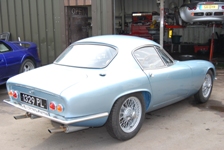


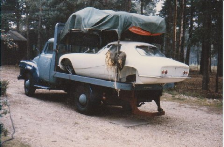
This great picture is of the Elite arriving with the current owner in 1962.
Many Lotus were sold in kit form during the period, this was so owner could avoid paying a car tax which was at the time chargeable on all new cars, but cars assembled by their owners were exempt. Providing the manufacturer did not assist in the assembly. The factory was not even allowed to provide instructions, to get around this the clever Mr Chapman provided a section in the workshop manual on how to replace the body in the event of a accident which was effectively the same job.
- Another recent work featured in the motoring press was an article by Nigel Fryatt in Performance Tuner magazine
- In a feature called "Our Cars"
WHO: Nigel Fryatt
WHAT: Lotus Elise S1
YEAR: 1999
MILEAGE: 51,300
CURRENT MODS: Elise S2 suspension
(Bilstein shocks, Eibach springs), plus full suspension set-up
COSTS THIS MONTH: £750
As a former Caterham Seven owner, I was
quite used to changing suspension set-ups. Indeed if you compete
with a Caterham, as I did in sprints, hillclimbs and the odd circuit
race, you get used to changing most things on a regular basis.
However, when it came time to hang up the race boots, I did think
that would all be behind me. That was one of the attractions of the
Elise, it has a great deal of the same appeal – being a stripped,
lightweight, dynamic, driver’s sports machine – but I did assume it
would be much more of a ‘park and drive’ beast. Regular yearly
servicing, perhaps the odd new set of tyres but with nothing more
technical than the odd wash and polish.
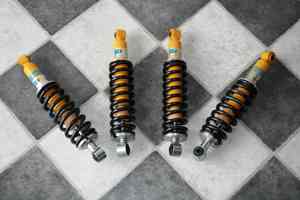
It’s not quite a straight swop as you also need S2 brackets for the rear, available from any Lotus outlet, but if you have the right equipment, you could do this yourself. Needless to say, that was not my plan and I left it to Lakeside to fit while I stood back and watched. The S2 strut and spring combination actually lowers the car 10mm, although it looks to me as though the rather knackered original springs had sagged over time and so the ride height difference is imperceptible. But when you get behind the wheel…
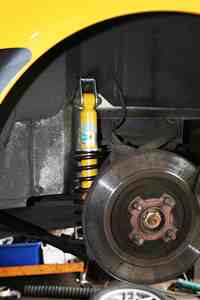
 Before that, however, the car was taken
to have it’s suspension correctly set-up. For a car like the Elise,
this is essential but to be honest it’s something that any car that
has significant changes to its suspension should consider. Of
course, having your geometry correctly adjusted is not something you
can see, you don’t bolt it on, you can’t polish it and you can’t
show your mates. But for some, and certainly for this Elise, it’s
one of the best ‘performance products’ you can buy for your car.
Before that, however, the car was taken
to have it’s suspension correctly set-up. For a car like the Elise,
this is essential but to be honest it’s something that any car that
has significant changes to its suspension should consider. Of
course, having your geometry correctly adjusted is not something you
can see, you don’t bolt it on, you can’t polish it and you can’t
show your mates. But for some, and certainly for this Elise, it’s
one of the best ‘performance products’ you can buy for your car.
I was taken over to tyre
specialists, Merritt’s of Woking.
Now this is no ‘quick and cheap’ tyre outlet and their Hunter DSP600
suspension geometry rig has to be state of the art for road cars.
The car sits, or almost floats, on 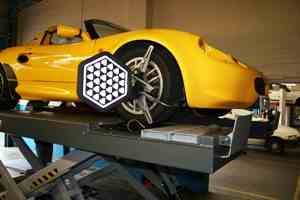 four ‘pads’ linked to a computer.
Each wheel then has a multi-adjustable clamp fitted to it, along
with four frying pan-sized reflective plates, which point towards
the two camera arms that are connected to the same computer. Now
that’s as technical as I can get! The rest is some kind of strange
high-tech magic. The computer’s camera sends a laser beam to the
reflective plates, catches the multitude of reflections, analyses
the results and registers the camber, caster, and toe-in on each
individual wheel accurately and quickly and records the results on
the computer screen so even the most inexperienced operator – or in
this case, me – can see what is going on.
four ‘pads’ linked to a computer.
Each wheel then has a multi-adjustable clamp fitted to it, along
with four frying pan-sized reflective plates, which point towards
the two camera arms that are connected to the same computer. Now
that’s as technical as I can get! The rest is some kind of strange
high-tech magic. The computer’s camera sends a laser beam to the
reflective plates, catches the multitude of reflections, analyses
the results and registers the camber, caster, and toe-in on each
individual wheel accurately and quickly and records the results on
the computer screen so even the most inexperienced operator – or in
this case, me – can see what is going on.
 It was pleasing to see immediately that
my Elise is a straight car and the settings weren’t that far out,
although the rear camber understandably needed adjustment. The rear
on the Elise has a simply but effective suspension where there are a
group of shims fitted to the top arm of the suspension. Add, or
subtract, shims and you alter the camber. One shim equals around
15min and for the Elise the ideal range is between 1deg36’ – 2deg00’
negative. If you want more that 2deg negative, for serious track
use, some people remove all the shims and machine the face further.
It was pleasing to see immediately that
my Elise is a straight car and the settings weren’t that far out,
although the rear camber understandably needed adjustment. The rear
on the Elise has a simply but effective suspension where there are a
group of shims fitted to the top arm of the suspension. Add, or
subtract, shims and you alter the camber. One shim equals around
15min and for the Elise the ideal range is between 1deg36’ – 2deg00’
negative. If you want more that 2deg negative, for serious track
use, some people remove all the shims and machine the face further.
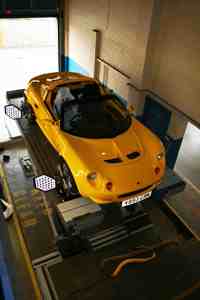
One gruesome thought is that I’ve been in motoring journalism for longer than a lot of PT readers will have actually been around, and while I’m not overtly cynical, I’m not easily impressed. But trust me, if you have an S1 Elise on original suspension, change it. Now. At around £500 for the struts and springs, plus the brackets, £120 for the suspension set-up by Lakeside and then throw in a further £480 for a set of Yokohamas fitted and balanced, this is not a cheap conversion, especially when you consider you can pick-up a tired Elise S1 for as little as £7,000/£8,000. However, trust me; your car will handle better, ride better, respond better to your driving and as a result, you’ll be much quicker. Maybe you can’t polish it or point at it, but this is one worthwhile modification.
